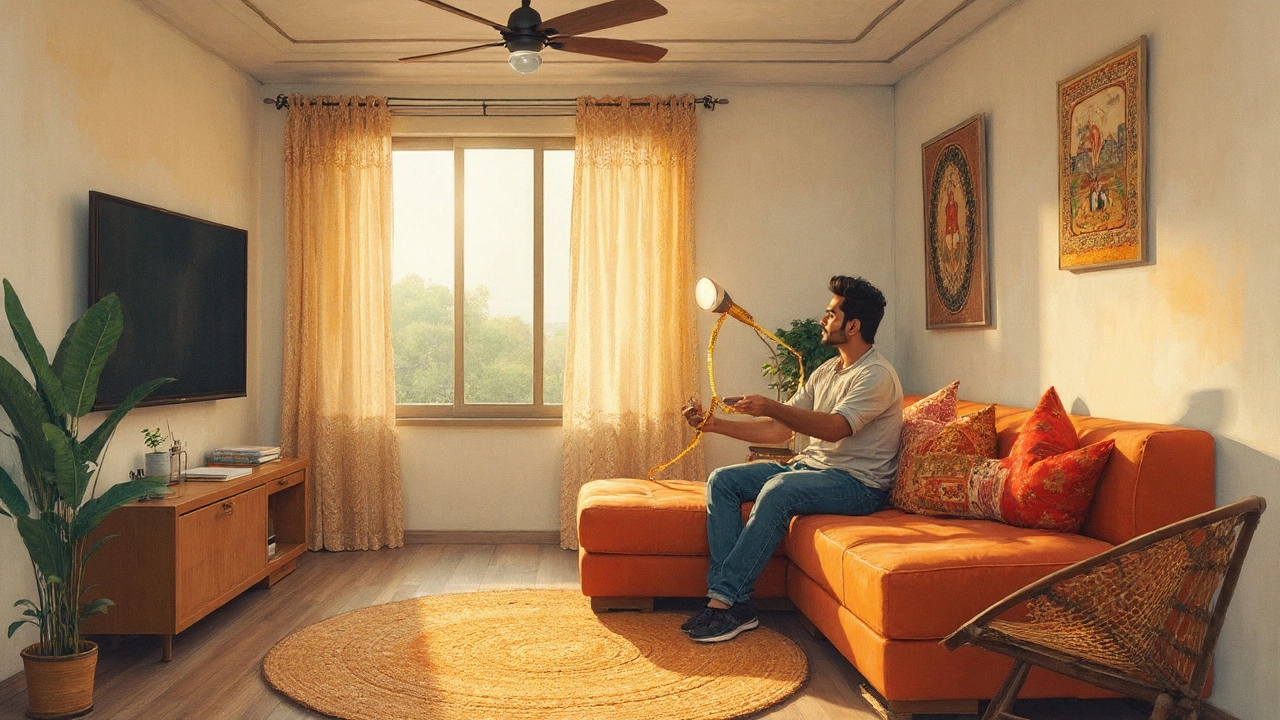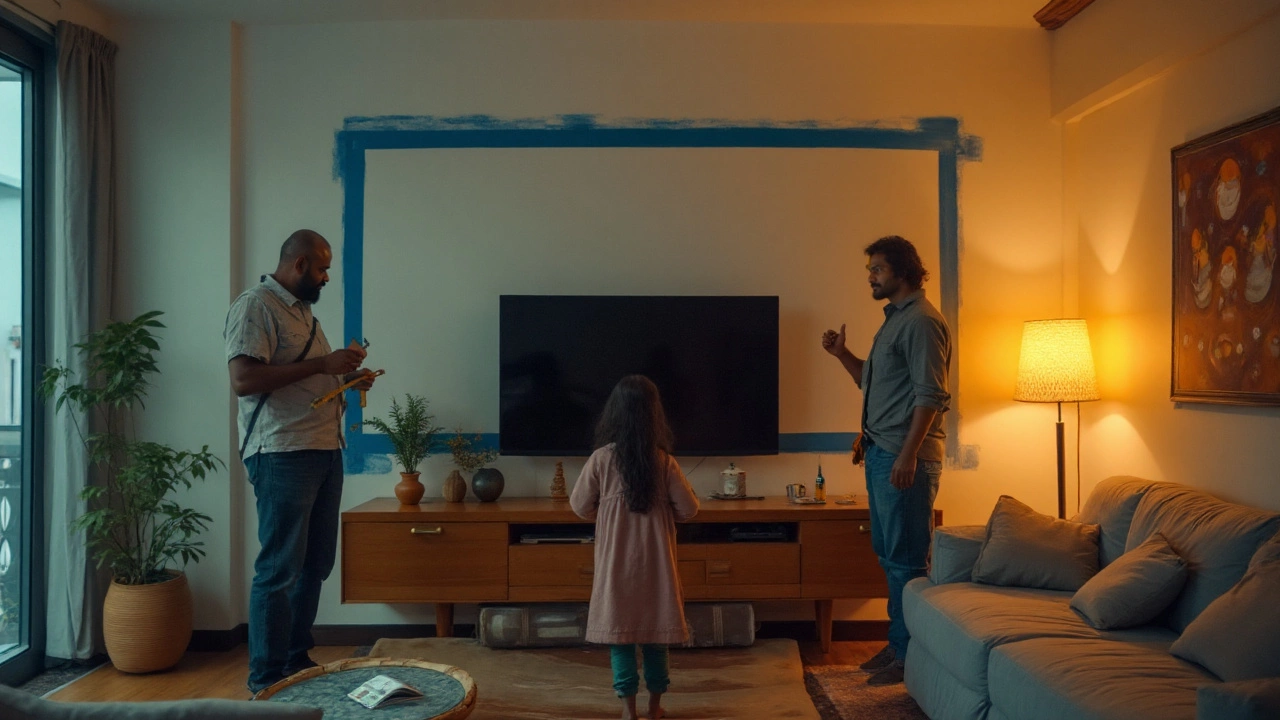You’re eyeing a bigger screen and wondering if a 65-inch will actually fit where your 55-inch sits now. The short answer: a 65-inch TV is roughly 8.7 inches (about 22 cm) wider than a 55-inch. That’s the number you needed, right? Below, I’ll show you the exact dimensions in inches and centimeters, how that plays with your TV stand or wall mount, and the viewing distance sweet spot so you don’t end up with a neck-ache or a return label.
TL;DR
- Width difference: about 8.7 in (22 cm) wider for a 65-inch vs a 55-inch (both 16:9).
- Typical widths: 55-inch ≈ 47.9 in (121.8 cm); 65-inch ≈ 56.7 in (144.0 cm).
- Height difference: about 4.9 in (12.5 cm) taller (55-inch ≈ 26.9 in / 68.4 cm; 65-inch ≈ 31.9 in / 81.0 cm).
- Screen area jump: roughly 40% more screen with 65 vs 55.
- Recommended seating: about 2.3-2.7 m for 55-inch; 2.6-3.0 m for 65-inch (4K content), based on SMPTE/THX angles.
- Stand fit rule: Your top surface should be at least TV width + 5-10 cm each side; check leg span if the TV has wide-set feet.
- Wall mount: Confirm VESA (often 300x300-400x400) and stud spacing (AU homes: 450 or 600 mm centers).
The exact width difference and why it’s the number that matters
TV sizes are measured diagonally, corner to corner. That’s why a 65-inch doesn’t look “just 10 inches bigger” than a 55-inch. Both are usually 16:9 aspect ratio, so the increase in width and height follows a fixed ratio.
For a 16:9 TV, width ≈ diagonal × 0.8716. That’s the key multiplier. Using that:
- 55-inch width ≈ 55 × 0.8716 = 47.9 in (121.8 cm)
- 65-inch width ≈ 65 × 0.8716 = 56.7 in (144.0 cm)
- Width difference ≈ 56.7 − 47.9 = 8.8 in (22.2 cm)
If you like neat numbers, remember this shortcut: every 10-inch jump in diagonal (at 16:9) adds about 8.7 inches of width and about 4.9 inches of height. Translate inches to centimeters with × 2.54. So yes, going from 55 to 65 brings just over 22 cm of extra width.
Height matters too, especially for wall placement and sightlines above a console:
- 55-inch height ≈ 26.9 in (68.4 cm)
- 65-inch height ≈ 31.9 in (81.0 cm)
- Height difference ≈ 5.0 in (12.6 cm)
Screen area grows faster than you think. Because area scales with the square of the diagonal, a 65-inch gives about (65/55)² ≈ 1.40 - around 40% more screen. That’s why a 65 can feel “way bigger” than it sounds on paper.
| Spec | 55-inch (16:9) | 65-inch (16:9) | Difference |
|---|---|---|---|
| Approx. width | 47.9 in (121.8 cm) | 56.7 in (144.0 cm) | +8.8 in (+22.2 cm) |
| Approx. height | 26.9 in (68.4 cm) | 31.9 in (81.0 cm) | +5.0 in (+12.6 cm) |
| Screen area | ≈ 1292 in² (0.834 m²) | ≈ 1809 in² (1.167 m²) | ≈ +40% |
| Recommended seating (SMPTE ≈30°) | ~ 89 in (2.26 m) | ~ 106 in (2.68 m) | + 17 in (+0.42 m) |
| Recommended seating (THX ≈40°) | ~ 66 in (1.68 m) | ~ 78 in (1.98 m) | + 12 in (+0.30 m) |
| Typical VESA | 300×300 or 400×300/400 | 400×300 or 400×400 | Check model |
| Typical weight (no stand) | 13-18 kg | 18-25 kg | +5-7 kg |
| Approx. box size (varies by brand) | ~ 140 × 85 × 17 cm | ~ 160 × 95 × 18 cm | Larger by ~20 cm length |
Real-world caveats:
- Bezels are thin on 2024-2025 models, but total width can vary by ±0.5-1.0 cm between brands.
- Ultra-wide 21:9 TVs exist, but are rare. The numbers above assume standard 16:9, which is what most 55- and 65-inch TVs use.
- Curved screens are uncommon now; if you find one, the front width is similar, but wall footprint changes slightly.
“For an immersive yet comfortable viewing experience, SMPTE recommends a minimum 30-degree field of view.” - Society of Motion Picture and Television Engineers (SMPTE)
If you want the single phrase to Google again later, it’s this: 65 vs 55 TV width = roughly +8.7 inches (+22 cm).

Will a 65-inch actually fit on your stand or wall?
Width is just one part. You also need to think about the stand surface, the TV’s feet or pedestal, wall mounting hardware, and where your couch sits.
Stand space
- Surface width: Aim for TV width + at least 5 cm clearance on each side; 10 cm feels safer and looks better. For a 65-inch at ~144 cm width, a 160 cm console is ideal; 150 cm is a tight but workable fit.
- Surface depth: Most 55-65-inch TVs need only 25-35 cm depth if they use a central pedestal. If the TV has wide-set feet near the edges, check the foot span in the spec sheet - it can be 90-120 cm on a 65-inch.
- Height: Eye level (middle of the screen) should sit around your seated eye height, roughly 100-110 cm from floor for most couches. A 65-inch is about 81 cm tall, so choose a console that keeps the center of the screen near that sweet spot.
Wall mounting
- VESA: Many 65-inch models are 400×300 or 400×400. Many 55-inch models are 300×300 or 400×300/400. Your mount must match the TV’s VESA and weight rating.
- Stud finding: Australian timber framing typically uses 450 mm or 600 mm stud spacing. Your mount should catch two studs; use appropriate fixings if masonry.
- Cable clearance: A 65-inch is taller, so check where the top edge lands. Leave space for top-venting and cable bends, especially if recessing.
- Tilt vs flat: If your seating is lower than the TV center, a slight tilt helps. Flat mounts keep things sleek but can increase glare if windows face the screen.
Viewing distance and comfort
- SMPTE’s 30° guideline puts you at roughly 1.6× the diagonal. That’s about 2.3 m for a 55-inch and 2.7 m for a 65-inch.
- THX’s 40° is more immersive - about 1.2× the diagonal: ~1.7 m for 55-inch and ~2.0 m for 65-inch.
- 4K makes sitting closer comfortable. If you stream mostly 1080p sports or FTA, a bit farther helps hide compression and noise.
Weight and safety
- Weight jumps by ~5-7 kg from 55 to 65. That’s still manageable for two adults, but use two people to lift and avoid panel flex.
- Anti-tip straps are cheap insurance if you have kids or pets. A larger screen has more leverage if bumped.
Style and glare
- Thin bezels help larger TVs look less bulky, but the wider glass reflects more. Check window positions; tilting blinds or a matte film can calm reflections.
- Ambient light behind the TV (bias lighting) reduces eye strain on big screens during night viewing.
Delivery fit
- Box size grows from ~140 cm to ~160 cm in length. Measure stair turns, lifts, and car boot openings before pickup.

Cheat sheets, examples, and answers to follow-up questions
Here’s a simple set of tools to make the call without second-guessing yourself.
Quick width math you can trust
- For any 16:9 TV, width ≈ diagonal × 0.8716.
- Ten inches more diagonal adds ≈ 8.7 inches of width and ≈ 4.9 inches of height.
- Convert inches to cm: × 2.54.
Fast fit checklist
- Measure your top surface width and depth.
- Check the TV’s total width (spec sheet) and the foot span if the feet are near the edges.
- Leave 5-10 cm side clearance; more if your stand edges are rounded or you have kids.
- Confirm VESA size and mount weight rating; verify wall studs at 450/600 mm centers.
- Mark the top edge on the wall with painter’s tape and sit down - does the top feel too high?
- Check cable reach: a 65-inch may push your power point or antenna lead farther than the 55 did.
Room examples
- Small lounge (sofa ~2.2 m from wall): A 55-inch fits comfort well. A 65-inch can work if you like an immersive feel (THX angle), but check glare and neck angle.
- Medium living room (sofa ~2.6-3.0 m): A 65-inch sits in the sweet spot and uses your space better than a 55.
- Open-plan area (3.2 m+): 65-inch is the minimum; 75-inch often makes sense here if your stand or wall can take it.
Common pitfalls to avoid
- Assuming “10 inches bigger” means “10 inches wider.” It’s about 8.7 inches wider at 16:9.
- Ignoring leg span. Many modern TVs have feet near the edges; they can overhang a narrow console even if the panel fits.
- Mounting too high. Center the screen close to eye level; tilting helps if you must mount higher.
- Buying the mount after the TV arrives. Check VESA and weight first; some 65s need a heavier bracket.
- Underestimating the box. Measure doorways and elevator depth if you live in an apartment.
Mini-FAQ
- How wide is a typical 65-inch TV? Around 144 cm (56.7 in), give or take a centimeter between brands.
- How wide is a typical 55-inch TV? Around 121.8 cm (47.9 in).
- So, how much wider is 65 than 55? About 22 cm (8.7 in).
- Is a 65 too big for 2.4 m viewing distance? Not at all for 4K content. It’s near the immersive end of recommendations (THX-like). If you watch a lot of 1080p, you might prefer slightly farther back.
- Do bezels change the math? Slightly. On 2025 models, bezels are thin, so total width rarely shifts by more than ~1 cm.
- Will my old 55-inch wall mount work? Maybe. If it’s rated for the 65’s weight and matches the new VESA pattern (often 400×400), you’re fine. Check specs.
- What TV stand size suits a 65-inch? 150-180 cm wide is the safe range. 160 cm looks balanced in most rooms.
- What about soundbars? A 65-inch leaves more room to slot a soundbar below the screen without blocking the panel. Check IR sensor placement.
Decision guide: stay 55-inch or jump to 65?
- Pick 55-inch if your console is ≤ 130 cm wide, seating is ~2.0-2.3 m, or you prefer a subtler look.
- Pick 65-inch if your console is ≥ 150 cm, seating is ~2.6-3.0 m, or you want a clear boost in immersion and readability for sports and subtitles.
Pro tips
- Painter’s tape trick: Tape the exact width and height of a 65-inch on the wall above your stand. Sit down and check edges against decor, speakers, and windows.
- Check foot type before buying: Central pedestal stands are friendlier to narrow consoles than wide-set feet.
- Glare test: At your usual daytime hour, hold a large black poster where the screen would be. If you see bright window reflections, consider a slight tilt mount or curtains.
- Don’t forget delivery: If you’re in an apartment, book the lift and measure the lift door. A 65-inch box is long.
Evidence and sources
- SMPTE’s 30° field-of-view recommendation underpins the longer viewing distance estimate.
- THX’s ~40° guidance supports the closer, more cinematic seating option.
- Consumer TV specs (2024-2025 models) confirm typical VESA patterns and thin bezel designs from major brands.
Next steps
- Measure your stand’s width and depth. If it’s under 150 cm, check the TV’s foot span carefully.
- Mark a 144 × 81 cm rectangle on the wall (approx. 65-inch panel) and sit at your usual spot. Comfortable? Good.
- Check your mount’s VESA and weight rating; confirm wall studs at 450 or 600 mm centers.
- Plan cable routing. Short HDMI leads that worked for the 55 might be tight with a larger panel.
- Book delivery when you have a second set of hands. Don’t lift a 65 alone.
Troubleshooting
- TV edges overhang the stand by a few centimeters. If it’s only the bezels and the feet are stable on the surface, you’re okay. If the feet overhang, swap to a central pedestal stand or wall mount.
- Can’t hit two studs. Use a wider wall plate mount or a plywood backing board fixed to studs, then mount to that. For masonry, use appropriate anchors.
- Reflections from windows. Shift the TV a few centimeters, tilt slightly, or add sheer curtains. Even small angle changes can kill a reflection line.
- Neck strain after mounting. The TV is too high. Lower the mount or add a tilt bracket to angle the screen toward eye level.
If you only remember one thing from this whole guide: a 65-inch is about 22 cm wider than a 55-inch. If your console is at least 150 cm and your couch is around 2.6-3.0 m back, you’ll likely love the upgrade.

